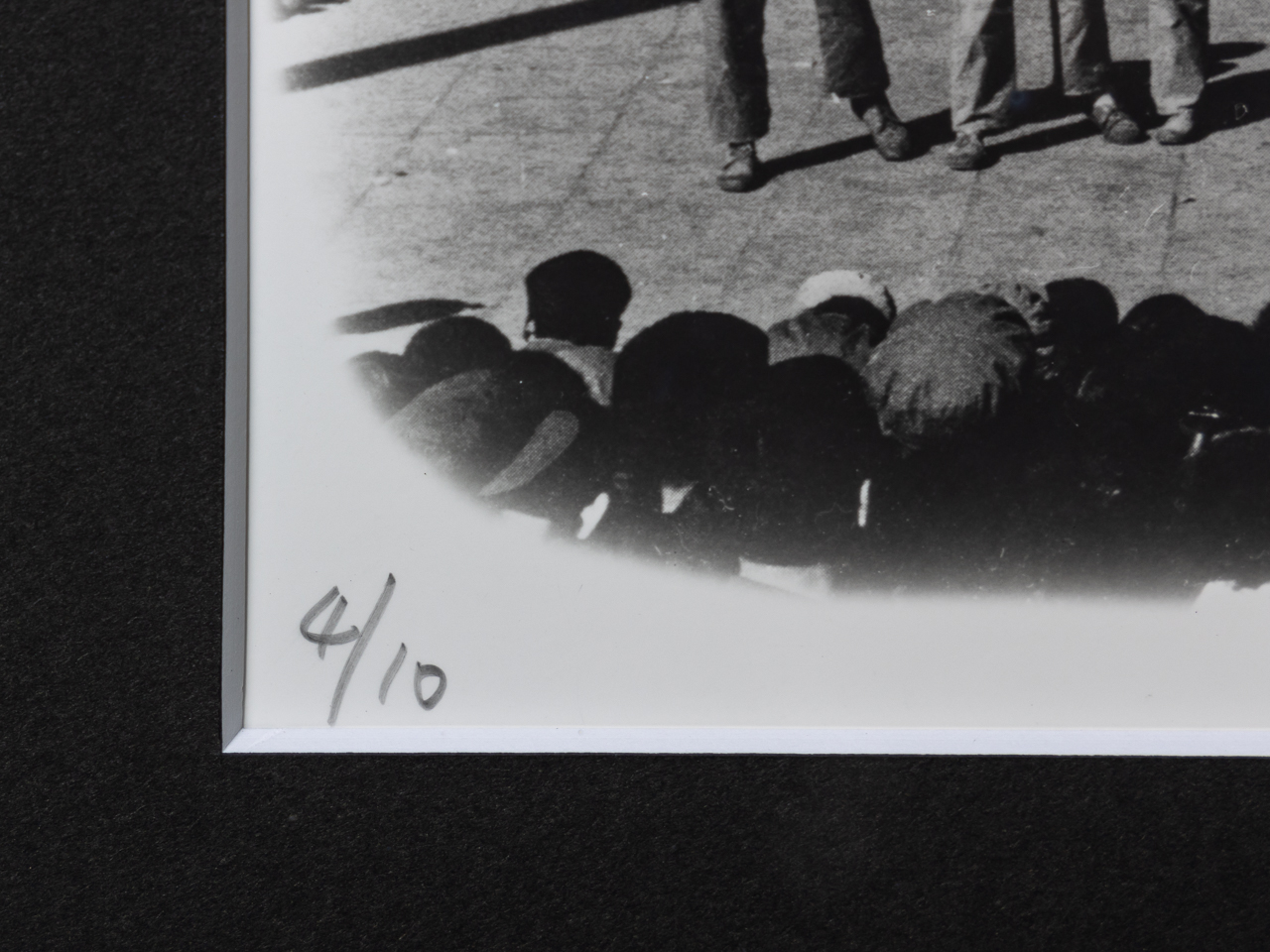牛 波/Niu Bo
牛波(1960~)は中国出身の現代美術家です。
1977年に詩作を中心とした文学活動を始め、1978年より北京画院にて水墨画を学ぶなかで、同地では弾圧されていた現代美術にも強い関心を持つようになり、1987年に来日を果たしました。伝統性と現代性を織り交ぜながら、新たな展開を見せる日本の美術界に触発された牛波は瞬く間に頭角を現していきますが、その活動のスケールは日本には収まりきらないほどでした。
中国時代の作品としては、北京天安門にかけられた毛沢東の肖像を自身の1967年当時の写真にかえたコラージュ作品【証拠肖像】(1985年)が挙げられますが、この時点で、既存の枠組みを飛び超えようとする牛波の前衛性が見てとれます。来日後は、マルセル・デュシャン(1887~1968)の【泉】(1917)のレプリカを自作し、実際に便器としてトイレに設置するインスタレーション、ジャスパー・ジョーンズ(1930~)の「標的」シリーズの複製に矢を射るパフォーマンスなど、20世紀の名作を引用しながらその意味を再考し、21世紀の芸術を切り拓いていく実験を試みました。さらに、セスナ機から生まれる飛行機雲で描く「大空絵画」を成功させたことで、それまでの美術のありかたを一変させ、まだ見ぬ新たな世界へと突き進んでいきます。その最たるもので、牛波の代名詞ともいえるのが「無重力アトリエ」です。「印象派の画家がアトリエを出なければ作品を描くことができないように、この大気圏外に脱出しなければ、既存の概念から自由であることは不可能であり、従って真に新しい文化を創造することは不可能である」という言葉の通り、牛波は1993年8月4日に「宇宙アトリエ1993」なるプロジェクトを実行に移しました。その内容は次の通りです。まず、Mu-300型ジェット飛行機の内部を白い和紙で覆い、牛波自身もその和紙でできた作業着を身につけます。それから何か所かに水彩絵具、油彩具、アクリル塗料などを入れた試験管や風船を配置すると、そのジェットを高度25,000ftまで上昇させ、その地点から何度か放物線飛行を繰り返すことで無重力状態をつくりだします。この下準備が整ったところで、容器に入った絵具類が飛沫となって浮遊し、白い和紙にオートマティックな彩色が施されていきます。かつてジャクソン・ポロック(1912~1956)が行った、床に置いたカンバスへのドリッピングのその先を目指すように、牛波は地球上の概念が成立しないテクノロジーアートに挑戦したのです。
その後、ニューヨーク、チベットへと拠点を移してから忽然と姿を消した牛波でしたが、2015年、故郷の中国に戻り活動を再開させます。美術界から退いていた期間、中国の山深くで命がけともいえる仏教の修業を積んだ彼は、修行場の樹木に縄をかけて宙づりになり、山肌に張り巡らせた支持体に無重力状態で描きこむという前代未聞の手法で水墨画を手がけました。
誰も想像できない、できたとしても実践がきわめて難しい芸術に挑戦し続ける牛波は、限りなく未来に近い、現代の最先端を走るアーティストといえるでしょう。
Niu Ba (b. 1960) is a contemporary artist from China.
He began his creative career in 1977, focusing on poetry. While studying ink wash painting at the Beijing Academy of Fine Arts starting in 1978, he developed a profound interest in contemporary art, despite the highly restrictive environment for such work in the region at the time. Niu Ba relocated to Japan in 1987. Inspired by the Japanese art world’s new developments—particularly its successful synthesis of tradition and modernity—he quickly rose to prominence. However, the sheer scope of his ambitious work soon outgrew the confines of the Japanese art scene.
Among his early output from his Chinese period is the collage, Evidence Portrait (1985). This provocative piece famously replaced the public portrait of Mao Zedong displayed in Beijing’s Tiananmen Square with his own 1967 photograph. Even at this early stage, Niu Ba’s avant-garde spirit—his clear drive to transcend existing frameworks—was strongly apparent.
After arriving in Japan, he began a series of conceptual experiments. He installed his own replica of Marcel Duchamp’s Fountain (1917) as a functional urinal in a public restroom. He also conducted a performance where he shot arrows at reproductions of Jasper Johns’ (b. 1930) Target series. Through these critical interventions, he re-examined the meanings of 20th-century masterpieces, pioneering a direction for 21st-century art.
Furthermore, his successful “Sky Paintings”, created using the contrails from a Cessna aircraft, radically transformed the very nature of art, propelling him into uncharted new realms. The ultimate embodiment of this exploration, and the work most synonymous with Niu Ba (who began consistently using the name Ushinami in Japan), is the “Zero-Gravity Atelier”.
This project was the ultimate expression of his core philosophy:
“Just as an Impressionist painter could not create without leaving his studio, one cannot be free from existing concepts without escaping this atmosphere, making truly new culture impossible”.
The “Space Atelier 1993” project, launched on August 4, 1993, carried out this statement. The interior of a Mu-300 jet aircraft was lined with white Japanese paper, and Ushinami himself wore a work suit made from the same material. Test tubes and balloons containing watercolors, oil paints, and acrylics were strategically placed throughout the cabin. The jet then ascended to an altitude of 25,000 feet, where it performed repeated parabolic flights to create a state of weightlessness. Once the paints were released, they became suspended droplets, automatically coloring the white paper. Moving beyond the dripping technique Jackson Pollock (1912-1956) once employed on canvases placed on the floor, Ushinami challenged the limits of technology-based art, creating work where earthly concepts and gravity no longer held sway.
After relocating his base to New York and subsequently to Tibet, Ushinami suddenly disappeared from the public eye. During this hiatus, he undertook life-threatening Buddhist ascetic practices deep in the Chinese mountains. A major work from this period involved him suspending himself from trees with ropes in his training grounds, where he created ink wash paintings in a state of self-induced ‘weightlessness’ upon supports stretched across the mountainside.
Continuously challenging art forms unimaginable to most, and often extremely difficult to execute, Ushinami remains an artist operating at the very forefront of contemporary practice, infinitely close to the future.





作品名:作品
サイズ:17×23cm(ゼラチンシルバープリント ed.10)
価格:100,000円
価格は税抜き表示です

